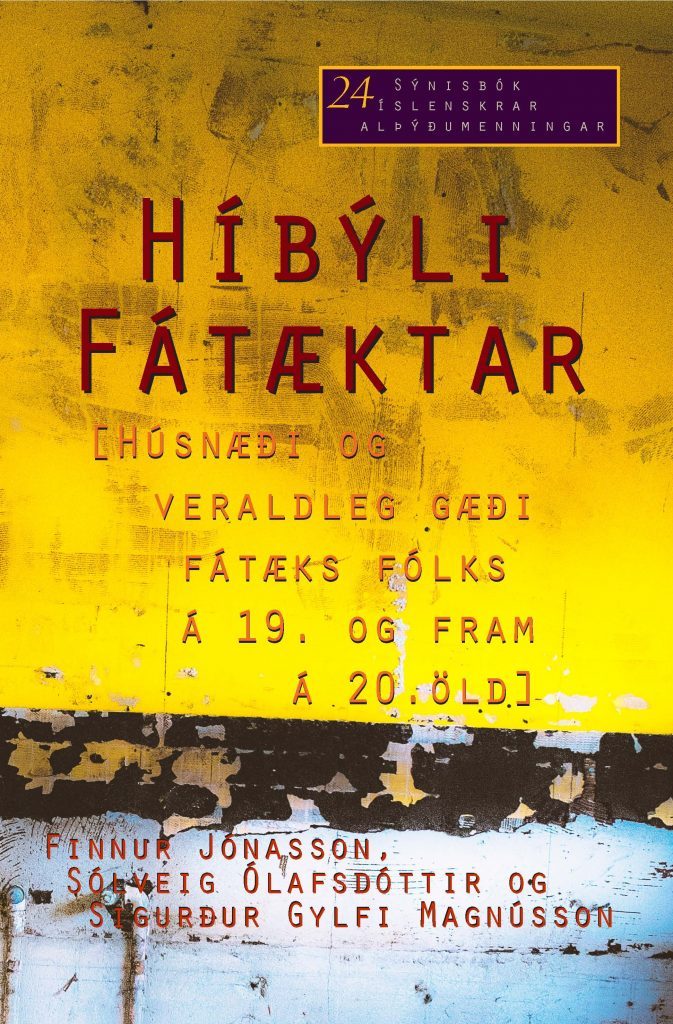 Homes of Poverty: Housing and material conditions of poor people in the 19th and early 20th centuries. Anthology from Icelandic Popular Culture 24. Co-authors: Finnur Jónasson og Sólveig Ólafsdóttir. 254 pages – (Híbýli fátæktar. Húsnæði og veraldlega gæði fátæks fólks á 19. og fram á 20. öld. Sýnisbók íslenskrar alþýðumenningar 24 (Reykjavík: The Center for Microhistorical Research and the University of Iceland Press, 2019).
Homes of Poverty: Housing and material conditions of poor people in the 19th and early 20th centuries. Anthology from Icelandic Popular Culture 24. Co-authors: Finnur Jónasson og Sólveig Ólafsdóttir. 254 pages – (Híbýli fátæktar. Húsnæði og veraldlega gæði fátæks fólks á 19. og fram á 20. öld. Sýnisbók íslenskrar alþýðumenningar 24 (Reykjavík: The Center for Microhistorical Research and the University of Iceland Press, 2019).
The objective of this volume and many others in the series Anthology from Icelandic Popular Culture is to draw the attention of potential readers to the life of people living in poverty, and to provide an insight into a world which must be deemed in many ways unusual and unfamiliar. In the book we seek to define what “poverty” means, and to explore the resources available to individuals and communities in responding to shortage and inequitable division of material resources, with the aim of establishing the concept of a Culture of Poverty. The volume comprises four separate sections, all of which address the subject of the homes and circumstances of people living in poverty in Iceland in the 19th and 20th centuries.
The first section, by Sigurður Gylfi Magnússon, professor of cultural history at the University of Iceland, is “Houses and homes of the common people. Poverty in Iceland in the latter half of the 19th century.” The author explores descriptions of poor people’s homes, drawn from autobiographies and memoirs of Icelanders born from the mid-19th century until the first decade of the 20th. These include accounts of both rural and later urban life. Contemporary debate on the circumstances and living conditions of the poor in newspapers and periodicals is also reported. Finally Sigurður Gylfi defines the principal features of the concept he calls the Culture of Poverty – which is manifested not only in lack of money as such, but also in rootlessness, a generalised insecurity, poor building materials, and lack of general hygiene. All this had a lasting impact on the emotional lives of the individuals concerned, and their personalities, which could transmit the impact to later generations.
Those who lived in poverty found it hard to escape, except by pure luck – for instance when a child was placed in foster care with a family who could ensure them a better life. Others struggled in poverty all their lives, and their children after them. It would be easy to assume that poverty was passed down in families, but Sigurður Gylfi reaches a different conclusion. In public discourse poverty was often presented as “hereditary,” and many of the measures applied were rooted in the fear that children raised in poverty would never learn to be self-reliant, and would always be dependent upon the authorities. But in truth a large proportion of Icelanders always lived on the brink of poverty: sometimes making an adequate living, but never secure from the threat of disaster, which meant only one thing – the family would be split up and have to seek poor relief. All in all, poverty is more properly seen as a shared national curse, rather than a burden on individual unfortunate families.
The second section of the book, by Finnur Jónasson, a PhD student of history at the University of Iceland, is “ ‘Esteemed Poor-Relief Board.’ Relations between the Reykjavík Poor Relief Board and the poor people of the town in the first decades of the 20th century.” The author gives an account of the origins of the Poor Law of 1907, and how it was implemented in Reykjavík in the period up to 1935. While the provisions of the law remained almost unaltered throughout that time, its implementation changed somewhat towards the end of the period studied. The only major amendments to the legislation focused mainly on the distinction drawn between the “deserving” and “undeserving” paupers. Poor Relief Boards were authorised to cancel the debts of “deserving” paupers, who thereby regained their civil rights, as their poverty was seen as beyond their control. The “undeserving,” on the other hand, were shown little mercy. Those who owed child support payments, or were seen as a nuisance in urban areas due to drunkenness or idleness, were treated increasingly harshly. The authorities’ growing preoccupation with “cleansing” the town of troublemakers is evidenced in collaboration between the police and poor law authorities in Reykjavík, which commenced after Hermann Jónasson was appointed chief of the Reykjavík police in 1929. Individuals who were regarded as a nuisance and had unpaid child support payments could be incarcerated in a workhouse or jail; there was no practical difference between the two, as the same building served both purposes.
Finnur focusses especially on the social conditions that informed the work of the Reykjavík Poor Relief Board, and the community’s attitude to poverty. In addition he discusses the circumstances of the poor in Reykjavík, and their own view of their situation. Grants paid to the poor were small, and poor relief was in practice always insufficient. When people applied for assistance from the board, their circumstances were invariably dire, and they lacked basic necessities such as food and fuel. The desperate plight of the applicants is testimony to the potent deterrent effect of the Poor Law, and the strict enforcement of social norms during the period in question.
The third section of the book, “Houses in a lava field. Everyday life and homes in Hafnarfjörður around 1900,” is by Sólveig Ólafsdóttir, a PhD student of history at the University of Iceland. She focusses on poor residents of the village of Hafnarfjörður around 1900, and especially their homes, material possessions and everyday life. She also explores the impact of their bleak living conditions on the individuals’ physical and mental wellbeing. Using a 1902 map of Hafnarfjörður made for Danish military survey, together with photographs, the author seeks to visualise the background to these people’s stories at that point in the community’s history.
Eighteen houses in Hafnarfjörður are visited: the conditions in which their inhabitants lived are frankly appalling. If people were in good health they had some options, but if a family experienced any setback the social “safety net” offered little support, and people often found themselves with nowhere to turn. There is evidence of discrimination between Hafnarfjörður natives and incomers from elsewhere in the country; but even being deemed a Hafnarfjörður native by descent offered no security if the local council suddenly decided to change its poor relief policy. One of the main conclusions of the study is that poor families were dangerously vulnerable if the mother of the family fell ill. Yet lone women – whether unmarried or widowed – had far more resources at their disposal than men. When a man became unfit to work, all he could expect was destitution.
In the “heritagisation” of the past which is characteristic of the present time, there is a strong tendency to romanticise poverty and the material conditions in which poor people lived in past times. The only way in which we can refute such a rose-tinted view of historic poverty is to carry out more research into the conditions of the underprivileged in any society at a specific period. At the same time, we should avoid drawing generalised conclusions from documentation of living conditions which we today cannot even imagine.
The fourth section of the book, “Manifestations of Poverty,” contains a unique archive of photographs taken in 1930-45 by bank employee Sigurður Guttormsson of the Westman Islands. The archive comprises a total of 230 photographs of poor people’s homes, taken all over Iceland. The archive, which Sigurður presented to the Confederation of Labour in an effort to spur it to action regarding housing for the poor, in now in the National Archives.
An interview with Sigurður about the photographs, published in daily Tíminn in 1962, is reprinted here. At the front of the book is an address by Drífa Snædal, president of the Confederation of Labour.
